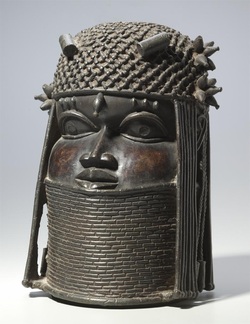Rattle-Staffs.

These staffs are from the Benin culture. They represent authority that is passed down in families, villages, priests or successors in general.[1] They would be used as parts of ancestral altars to commemorate current and past leaders. These were carved from wood for everyone except the Oba’s who would have them casted from brass and sometimes from ivory. On the top of the staffs there would be a slit that would house a wood or clay cylindrical rattle. This rattle was used to call attention to spirits so that they would come to their altar and make themselves present. These staffs were lined up by the altar where they symbolized the community and the continuity from generations of being passed down. On the Oba’s staff there are often figures or mudfish represented. It’s also said that the spirits from past Oba’s are housed within the staff and continue to be passed on.
[1] Kate Ezra, Royal Art of Benin, (New York: The Metropolitan Museum of Art, 1992), 91-96.
Africa, Nigeria, Benin, Rattle Staff, 20th Century, wood, 149.5cm x 7.5cm x 8cm, (The Cleveland Museum of Art Collection)
[1] Kate Ezra, Royal Art of Benin, (New York: The Metropolitan Museum of Art, 1992), 91-96.
Africa, Nigeria, Benin, Rattle Staff, 20th Century, wood, 149.5cm x 7.5cm x 8cm, (The Cleveland Museum of Art Collection)
Bronze Heads.

These heads from Benin are casted in honor of the Oba, or the King of Benin. For royal Oba’s each has one casted to represent their authority. There are often holes on top of the bronze heads so that carved ivory tusks may be put into them. Every Oba has a bronze head that is similarly casted because they are all casted from the same mold or very similar molds. Each one is simplified with a traditional headdress.[1] The headdress is a netted coral bead cap that sometimes has two wings that stand up. There is also a ring base on the necks that are sometimes decorated with different animals. These animals describe each Oba specifically. Examples of this include elephants, oxen or lions. The queen mothers of the Bini will sometimes have these bronze heads casted for them as well but they usually did not have the animals adorned on their necks.
[1] Dmitry Olderogge, and Werner Forman, The Art of Africa Negro Art, (Prague: The Hamlyn Publishing Group Ltd, 1969), 14-16.
Africa, Nigeria, Edo, Benin City, Head of a King, 1600s, bronze, 29.9cm x 21.6cm x 20.4cm, (The Cleveland Museum of Art Collection)
[1] Dmitry Olderogge, and Werner Forman, The Art of Africa Negro Art, (Prague: The Hamlyn Publishing Group Ltd, 1969), 14-16.
Africa, Nigeria, Edo, Benin City, Head of a King, 1600s, bronze, 29.9cm x 21.6cm x 20.4cm, (The Cleveland Museum of Art Collection)
